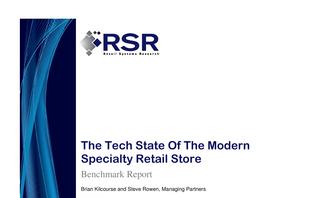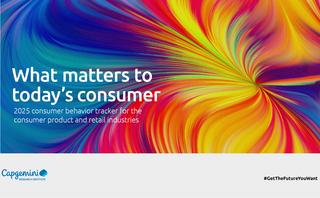274 notes tagged as ["omnichannel"]
Filter your results by choosing one or more tags below or type your query in the search field above.
-

Retailers face rising customer expectations, higher costs and pressure to innovate faster. The problem isn’t ideas — it’s the friction of legacy systems, content silos and disconnected workflows.
This guide shows leaders how to streamline operations, personalize at scale and accelerate time-to-value with modern content strategies powered by retail tech that adapts with you.
You’ll learn how to:
Simplify operations by centralizing and repurposing content across channels
-

Being global isn’t enough. Around the world, today’s shoppers expect more – more relevance, more convenience, more consistency. We surveyed over 6,000 consumers across the US, UK, France, Germany, and the Netherlands to find out what they really want from enterprise retailers – so you can win their loyalty. We found out:
• What shoppers demand from enterprise retailers in exchange for their loyalty
-

Billions spent. Trust lost. We break down the cultural and operational failures behind today’s disconnected customer experiences. Picture this: You’re a customer living in a world where brands promise you the moon but deliver a handful of space dust.
The Gist
The disconnect is real. Despite massive investments in omnichannel strategies, the overwhelming majority of customers expect unified experiences while only a small fraction of businesses actually delivers them, creating substantial financial losses for nearly half of all sellers.
-
You are currently enjoying the free trial mode which gives only back 3 results for each of your searches.
Click on Reset Search Tags to try another search.
Free NewsletterOnly paid members can get full access to the most recent content, create their own tags & personal folders, assign search results to specific projects and much more… all of this for less than 99c a day.
-

CX in 2030 - Future of the omnichannel contact center
In 2023, 57% of consumers felt their experiences with businesses were getting worse. In 2024, 55% expressed that sobering sentiment. Unfortunately, that slight improvement was not the start of a course correction. According to CCW Digital’s 2025 Consumer Preferences Survey, an alarming 59% now feel that experiences are headed in the wrong direction.
The regression is unsurprising. In addition to experiencing many of the same pain points they have for years, including long wait times, repetitive questions, and impersonal interactions, consumers are encountering new challenges and reservations related to artificial intelligence (AI). Indeed, the technology that was supposed to alleviate customer frustration is only exacerbating the ill will. Clearly, brands are doing enough to “compete on the customer experience.” They are not doing enough to make their promises of “customer centricity” a reality.
-

The race to unified commerce
If you’re leading digital growth, operational change, or customer experience, this report is built for you. The Race to Unified Commerce explores how today’s most agile brands are overcoming complexity to create connected, profitable journeys across every channel with fewer silos, smarter systems, and sharper focus.
Retail is no longer defined by isolated moments. It’s a continuous experience where customers expect every interaction to feel seamless, relevant, and rewarding.
-

What lies behind Nike's return to a multi-channel strategy?
Nike has recently pivoted away from its “ Consumer Direct Acceleration” strategy in favor of a more multi-channel distribution approach. What does the data say about this shift? We dove into traffic numbers and audience composition metrics to find out.
Nike’s Strategic Pivot
In 2020, Nike introduced its “ Consumer Direct Acceleration” strategy that had aimed to expedite the company’s DTC pivot in an effort to regain control of the brand and own the customer relationship directly. But the emphasis on owned channels did not yield the desired results – in fact, the move away from wholesale may have helped smaller sneaker companies take over shelf space and market share from the legacy sportswear brand.
-

Capturing consumer attention in a fragmented media landscape
In today’s media-saturated world, capturing consumer attention is more challenging than ever. Traditional advertising strategies alone are no longer enough. To maximize reach and impact, advertisers must embrace on-the-go video - a powerful solution that engages consumers outside the home and at key decision-making moments in their daily lives.
This playbook explores how on-the-go video drives incremental reach, attention, ad effectiveness, and measurable impact, making it an essential component of any omnichannel strategy. Backed by data and real-world success stories, it demonstrates why brands leveraging on-the-go video can create powerful connections and drive meaningful results. Read on now to discover how you can:
-

How Mondelez and Unilever are winning consumer loyalty in 2025
With each passing year, the bar for consumer engagement steadily gets higher and higher. Shoppers are moving between digital, in-store, and social without missing a beat, and they expect brands to keep up. That’s forcing marketing teams to rethink how they operate, how they collect and use data, and how they build loyalty in a retail-first world.
In this post, we unpack the key takeaways from a panel discussion with consumer products industry experts, Cristina Marinucci (Mondelez International) and Melda Hamarat (Unilever), at the SAP Emarsys Festival Personalization Masterclass. The conversation covered everything from breaking down internal silos to scaling personalization, working with limited data access, and applying AI in ways that actually make a difference.
-

Mastering the multi-touch consumer journey in 2025
New research reveals the attribution challenge of 2025: While 83.8% of retail dollars are spent in-store, consumers typically engage with brands 3+ times across digital channels before purchase. For high-earning consumers ($250k+), this number jumps to 5+ touchpoints.
Today’s consumer journey is complex, with consumers discovering and researching on- and offline, and across digital channels. Our new report explores insights from 1,000 US-based adults on what drives consumers to purchase, and offers strategic guidance for marketers.
-

The tech state of the modern specialty retail store
While “the store of the future” has been a fascination to the retail industry for over a century, the cold truth is that stores today look and feel far too similar to how they did 10, 15, and in many cases: 20 years ago. When will the promise of all the miraculous technology that surrounds us find its way into retail stores en masse?
To find out, we conducted a different type of research than our usual annual Store Report. Rather than survey all product segments, revenue bands and performance levels, we queried the retailers who are most likely to be at the forefront of technology-enablement in their stores – fashion & specialty retailers – all with high annual revenue. It also focuses on retailers that are outperforming the norm in sales, and as such, can be seen as a deep look into a very specialized – and advanced – set of the retail market.
-

What matters to today's consumer 2025
Consumer preferences and purchasing behaviors are constantly evolving. But how exactly are they changing? What Matters to Today’s Consumer?, a new report from the Capgemini Research Institute, sheds light on key trends shaping the consumer landscape. The report is based on a comprehensive global survey of 12,000 consumers aged 18 and over across 12 countries: Australia, Canada, France, Germany, India, Italy, Japan, the Netherlands, Spain, Sweden, the UK, and the US.